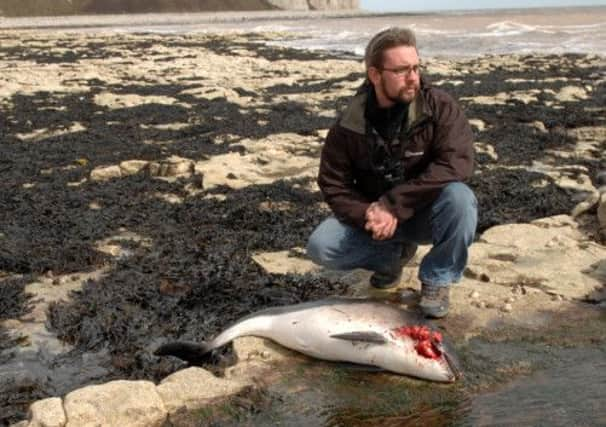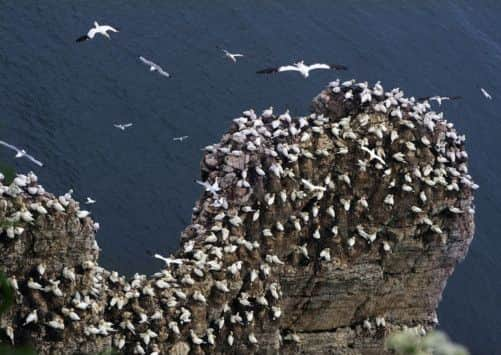Centre aims to turn tide of conservation for North Sea


Anthony Hurd is in his element. He first fell in love with the coast on family holidays as a child and those summers spent messing about in rockpools left a lasting impression on the man who is now manager of Yorkshire Wildlife Trust’s new Living Seas Centre at Flamborough Head. His office is the quiet South Landing and it’s a job, he happily admits, which mixes business with pleasure.
It wasn’t always this way. Until a few months ago, the team was based in York, 40 odd miles from the nearest sand bank. They compensated for the landlocked location with regular events and trips to the coast, but the new centre means the team, which includes a large number of volunteers, is much better placed to monitor closely what’s happening both out at sea and on the sands.
Advertisement
Hide AdAdvertisement
Hide AdAs it turned out, the move couldn’t have been more timely. Just a couple of weeks after the official opening of the centre at Easter, Anthony watched as weeks of bad weather devastated the area’s marine population. Just a few miles from Flamborough the sands were littered with tens of thousands of animals caught out by an unseasonal drop in temperatures and high winds.


In just one 10 mile stretch the death toll was put at 150,000 velvet swimming crabs, 10,500 edible crabs, 2,000 common lobsters and 635,000 mussels. The National History Museum’s strandings team also reported 150 porpoises had been washed up on the East Coast.
Aside from the odd hailstorm, the picture is a little quieter today, but as Anthony wanders across the sands turning over rocks and pointing to the various crabs and sand worms living underneath, he admits the impact of those storms which raged unabated for almost two weeks may not be known for some time.
“It was pretty horrific. We were finding lobsters turning up in rockpools and the emaciated bodies of seabirds were everywhere,” he says.
Advertisement
Hide AdAdvertisement
Hide Ad“Most of the time when you look out to sea there’s no real way of knowing what’s going on underneath the waves.
“When the weather turned, the delicate balance on which marine populations turn, very quickly became visible.”
One of the aims of the new Living Seas centre is to raise awareness of the need for marine conservation and to link up with other organisations like the RSPB which has a reserve at nearby Bempton Cliffs, which also saw its puffin population decimated by the icy March weather.
While those birds which did make it to the cliffs seem to be thriving, many species have seen their normal breeding window knocked out by up to a month.
Advertisement
Hide AdAdvertisement
Hide Ad“The last time there was anything like it was back in 1947,” Steve Race, education officer at the Bempton Cliffs RSPB. “From just south of Bridlington to just north of Whitby around 400 puffins were washed ashore. It was the perfect storm as the bad weather hit just as a lot of youngsters were making their way back to the breeding ground and a lot of the birds were in the middle of their annual moult, which meant they were temporarily unable to fly.
“It’s not just the puffins which have been affected. Everything has been put back three to four weeks and some birds only have a small window in which to breed. We’ve noticed the kittiwakes, one of Bempton’s eight key species, have been building their nests pretty frantically. These are basically small seagulls, so they are pretty hardy, but the weather was so bad it also hit them hard.
“Long-term we don’t really know what the impact on the puffin population will be, because there are so many factors to take into consideration. Aside from extreme weather conditions, which seem to becoming more frequent, we are also noticing the impact of climate change.
“Puffins feed off sand eels which in turn feed off cold water plankton. However, with the waters having warmed by about 2-3C that plankton has already started to move both further out and further north. Things are changing, but at the moment we are playing a waiting game.”
Advertisement
Hide AdAdvertisement
Hide AdThe new Living Seas Centre is a fairly unassuming building, nestled next to the South Landing car park, but it’s what will go on inside which will count. Partly a coastal classroom to allow schoolchildren to get close to marine life and partly a visitor centre, it will also play a key part in the trust’s campaign for the introduction of Marine Conservation Zones.
When the Marine and Coastal Access Act of 2009 was introduced it seemed that UK waters were on the verge of enjoying much greater protection. Currently less than 0.001 per cent of UK seas are considered fully protected and campaigners hoped the tide was about to turn in their favour.
In all 127 new zones, including seven in Yorkshire, were recommended for approval, including seven in Yorkshire, but just when campaigners hoped the paperwork would be rubber stamped by Government, the goal posts were changed.
Having previously said it would accept recommendation of areas on “best available evidence”, ministers upgraded the criteria to “peer reviewed research”. The result was that less than a quarter of the zones met the new standards.
Advertisement
Hide AdAdvertisement
Hide AdThe hope is that by drawing attention to the myriad of marine life which lives beneath the waves and making people aware of the threats it faces, from damaging trawler activity to pollution, pressure will mount on the Government to speed up the protection process.
“Having the centre is really important for our campaign work because now we are just a few steps from the area we want to protect,” says Anthony. “It makes a real difference that we can not only talk to people about the varied marine life we have right on our doorstep, but we can actually show them.
“It was by going rockpooling as a child that my love of the coast was really ignited. We didn’t live by the sea, but we spent a lot of time in Dorset. Having that connection with the coast is really important and we hope that’s what the centre can bring to other people.”
In a week when it was announced that only two Yorkshire beaches had been awarded Blue Flag status, Yorkshire’s coastline could certainly do with a few champions.
Advertisement
Hide AdAdvertisement
Hide AdUnder tough new European Union standards, designed to improve the quality of bathing water, only Scarborough North Bay and Whitby, along with Cleethorpes in Lincolnshire, retained the award, with the title stripped from Bridlington North, Hornsea and Withernsea.
“The Yorkshire coast is a real treasure trove and something to be proud off, but we do need to shout about it more,” says Anthony. “When you tell people that the North Sea is home to humpbacked whales they often look in disbelief, but they are there.
“We do need to be more proactive and one of the projects we are working on is the launch of snorkelling trips.”
While the North Sea might not be able to offer the warm waters of the Mediterranean or the exotic fish and coral of somewhere like the Maldives, Anthony is convinced there is a market for seeing what lies beneath.
Advertisement
Hide AdAdvertisement
Hide Ad“There is a big difference between seeing piles of seaweed lying on the beach and seeing it underwater where it really comes alive,” he says. “Myself and a colleague have completed our diving training with the aim that we can start to take groups out to somewhere like Thornwick Bay, where it is also possible to access the old smugglers’ caves.
“We’ve been out a few times now and while the visibility is not always brilliant, there is still a lot to see. The sea is as much a part as Yorkshire’s heritage as the Dales and the Moors and if we can increase access and allow people to explore the waters on their doorstep, then I really do believe that we have the best chance of protecting it in the future.”
An abundance of life beneath the waves
The North Sea is 600 miles long, 350 miles wide and covers an area of approximately 222,000 square miles. Its waters support more than 230 species of fish, as well as thousands of seabirds.
At Flamborough Head, each year the cliffs support around 200,000 nesting seabirds, including fulmars, razorbills, guillemots, auks, puffins and kittiwakes. Underneath the water is a three-mile chalk and limestone reef, the largest in Europe.
Advertisement
Hide AdAdvertisement
Hide AdBetween the chalk pillars, the sandy seabed is home to lobsters and clumps of reef-making worms.
Growing on top of the pillars are waving kelp fronds, which provide a home to small animals such as red algae and sea urchins.
The nutrient-rich water forms a concentrated food supply off the headland, meaning fish, birds, whales, dolphins and porpoises congregate there to feed.
As a result of the erosive power of the North Sea, Flamborough has more than 200 submerged and partly submerged sea caves. The largest caves extend more than 160ft inland from their entrance on the coast.
Advertisement
Hide AdAdvertisement
Hide AdOctopuses, conger eels and large lobsters can be found lurking within the caves. The cave walls are often covered in a solid mosaic of red, orange, white, yellow anemones and sponges.
Further out to sea at Dogger Bank, the ancient underwater mountains are home to clams, sea potatoes (a type of sea urchin), shrimps, millions of sand eels and worms.
The numerous species means the area also provides a hunting ground for thornback rays, dogfish, plaice and cetaceans.